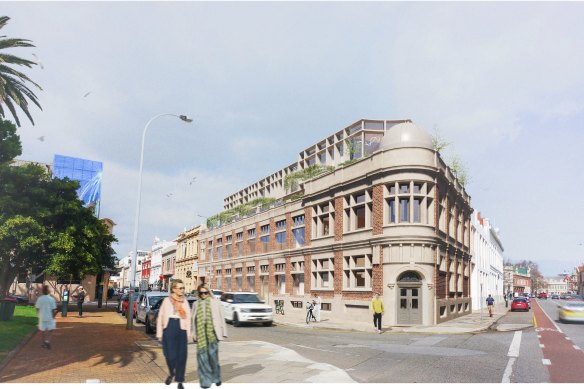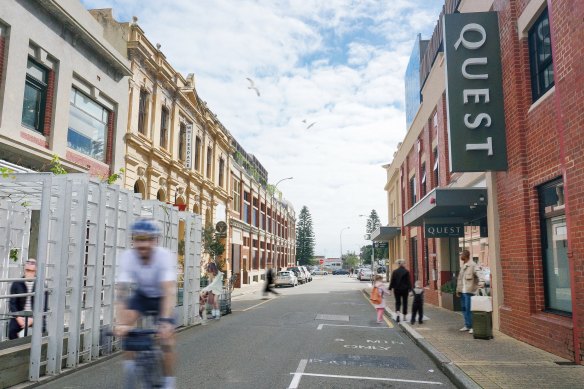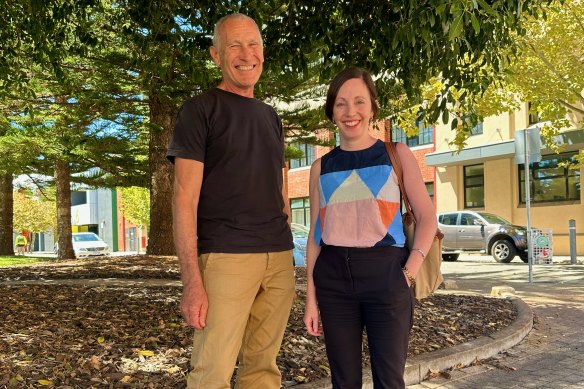This was published 4 months ago
The price of preservation: What will it take to protect Fremantle’s endangered heritage?
It is one of Western Australia’s premier tourism experiences — wandering through Fremantle’s West End on a Sunday afternoon and taking in what is considered the best-preserved 19th-century harbour-town streetscape in the world.
While most of St Georges Terrace in the Perth CBD fell prey to the developer’s wrecking ball, Fremantle’s young activist community in the 1970s fought a heroic battle to preserve its past, with the entire West End, the jewel in the crown, now heritage-listed and beloved by locals and visitors.

Debate rages over the future of heritage-listed buildings such as this.Credit: Artist’s impression of redevelopment proposal.
However, the buzz of dining, drinking and shopping against such a pretty period backdrop disguises the fact that many of the West End’s Gold Rush-era buildings are under-utilised and badly in need of repairs their owners — including the City of Fremantle and the state government — are unwilling to undertake. Quite simply, these old piles are money pits.
A striking solution has been put forward by uber-developer Adrian Fini and business partner Nic Trimboli (the team behind Little Creatures, Bread in Common and Vin Populi among others) with their proposed makeover of one of Freo’s most cherished architectural artefacts: the former Robert Harper Building on the corner of Pakenham and Phillimore streets.
While there have been many alterations to the port city’s heritage-listed buildings the Fini/Trimboli proposal, which includes adding two extra floors for apartments sitting atop office space, will be highly visible and make considerable impact on the streetscape.
So it is not surprising that when their plan got the thumbs up from the City of Fremantle, Heritage Council and the state government’s development accelerator the Joint Development Assessment Panel, Freo’s heritage warriors arced up, arguing that allowing a developer to drop two extra floors atop such a prominent building sets a dangerous precedent.
“Far from ‘breathing new life’ into the West End, it is a contagion that when repeated will be its kiss of death,” thundered former councillor Gerry MacGill in his contribution to a series in vibrant local website The Shipping News, which invited both sides to put their cases.
“While no doubt making an important contribution to the economic viability of the development, [the added floors] overwhelm the cupola and destroy its landmark significance,” wrote MacGill.
Spacemarket’s Sarah Booth, charged with keeping the building activated during the planning and application process, believes the Fini/Trimboli proposal exemplary, balancing heritage concerns with commercial reality.
“When you look at the track record of Adrian Fini I find it hard to fathom how there could be any opposition to this development,” says Booth, who is also community development lead at Fini’s Hesperia.
“The West End of Fremantle cannot be preserved as a museum with everyone shoehorning themselves into buildings that are badly in need of repair. They are cracking and splintering and the basements are flooding,” says Booth as she shows me through the Robert Harper Building and introduces me to her temporary residents, who are enjoying the cheap rent until work begins.

The streets of Fremantle.
“I understand wanting to keep them as they are, but it is simply not practical or financially viable. Look at what Adrian did with the Treasury building in the city and what he and Nic are doing in Fremantle. Their work is always the highest quality.”
Fini Group development director Jo Bennett says that restoring and repurposing an individual building such as the Robert Harper does not make much sense financially because they have such low margins and there is so much risk attached to it.
“It’s a labour of love,” says Bennett. “Adrian and Nic are prepared to invest into this venture because they’re deeply committed to Fremantle and want to make it a vibrant place to live and work and visit.
“So we don’t think of this as investing in just one building. It’s investing in a neighbourhood and a community. It’s all part of an ecosystem with a long-term benefit,” Bennett says.
Bennett argues that in some cases the best way to regenerate heritage-listed buildings is to add to the top, even though this is what triggered the Freo councillors who sit on the JDAP, Andrew Sullivan and Ben Lawver, to vote against the proposal.
“In the past those who have tried to make heritage buildings more financially viable have added extra floors into the existing space. In our opinion this really impacts on the integrity of the building. We wanted to maintain the heritage building floor-to-floor, so with the Robert Harper building we proposed a rooftop addition, which we believe is appropriate for this particular site.”
Fini and Trimboli’s architect, Fremantle-based Michael Patroni, says the sustainability demanded of newly restored buildings goes beyond access and compliance. They also need to be made financially sustainable.
“There is a short supply of A-grade offices in Fremantle, so creating something for tenants who are prepared to pay more for space will ensure the building is set up for another half-century of life,” Patroni says.
“Most of the renovations that have been done in Fremantle since the 1970s are largely a coat of paint, which has enabled them to have 30 or 40 years of life. But now they have deteriorated to such a point where you have to say, ‘where do we go from here?’”

Fremantle architect Michael Patroni and Fini Group Development Director Jo Bennett.Credit: Mark Naglazas
Patroni admits his additions do break the period mould, but says they will add visual appeal.
“It’s the kind of thing they do in heritage cities around the world. It’s very exciting,” Patroni says.
While the Fini/Trimboli proposal has received plenty of support, not the least from building owners in the area, the Fremantle Society’s John Dowson is “devastated”.
“It’s a precedent that will destroy the West End,” says an outraged Dowson.
“The Robert Harper building is classified as ‘exceptional’. That’s exceptional in its own right. It’s no longer exceptional when you stick two storeys on top of it. The message is now clear: anyone can stick two storeys on the top of a building in the West End.”
Curtin University’s world-renowned urban design and sustainability expert Peter Newman was one of those legendary 1970s activists who stopped developers turning Marine Parade into a freeway and ripping the historic heart from the port city. He has taken the side of those who want to see development guidelines relaxed.
“I’ve lost a few friends because of my point of view,” laughs Professor Newman.
“Everyone wants to preserve the heritage quality of these buildings, but they need to be regenerated or they fall apart. We’ve rebuilt our house four times now,” says Professor Newman, referring to the 1860s cottage in Russell Street he bought in 1974, “and each time we have improved its heritage quality while making it a comfortable modern home.”
He says governments not have the money to preserve the thousands of heritage buildings across the state.
“We’ve had enough dying buildings in Fremantle sitting there for 20 or 30 years like the Wool Stores. We have to constantly work out ways in which money can be made that will allow us to keep the buildings.
“While you need regulations to preserve the facades and as much of the inside as possible, we must have entrepreneurs like Adrian Fini to make these buildings profitable and secure their futures.”
Read more
WA Police officer dies in tragic accident at own engagement party
Scarborough woman ‘willing participant’ in threesome: rape accused
They’re cheap and ugly. But these Perth houses are flying off the shelf
Start the day with a summary of the day’s most important and interesting stories, analysis and insights. Sign up for our Morning Edition newsletter.